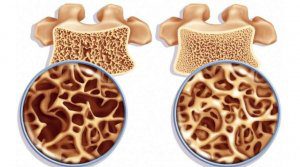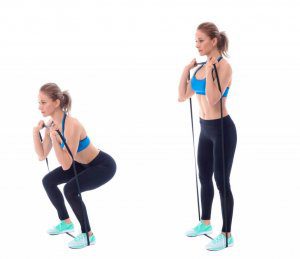Resistance Band Exercises For Bone Density.
As we age, unfortunately, loss of bone density is almost inevitable. Several factors determine how quickly we lose bone mass. Luckily, there are things such as resistance band exercises that can do to reduce the speed of bone density loss as you age.
First, we will take a closer look at why people lose bone density and when. We will also discuss the relationship between bone density loss and gender. Then, we will examine why we should do resistance band exercises to maintain bone density. We will also provide you with some examples of resistance band exercises for you to try.
Why do people lose bone density and when?
As you may already know, we all lose some bone density as we get older. Over time, as our bone density decreases, we may develop osteopenia. When it comes to bone density loss, it is important to note that osteopenia is not as severe as osteoporosis.

After we hit middle age, our bodies are unfortunately not able to make new bone mass fast enough. Most people reach their peak bone density at the age of 30 and after that, they begin to gradually lose their bone mass (HealthLink BC, 2019). Therefore, age is one of the most common reasons for losing bone density.
In addition to age, there are other factors that may impact your bone density. Some medications and health issues may also contribute to bone loss.

For example, long-term use of corticosteroids, which are often used to treat a number of different ailments, negatively impact our ability to absorb calcium, which is important for maintaining bone mass (“Corticosteroid-Induced Osteoporosis”, 2019).
Eating disorders and metabolic conditions that hinder our ability to absorb vitamins and minerals may also contribute to bone density loss.
Furthermore, exposure to radiation as well as chemotherapy has a negative impact on bone density. Not only that but also being excessively thin is another reason why people lose bone density.
While we may naturally lose bone density due to age, medical conditions, or genetics, certain habits, such as excessive drinking, smoking, and prolonged inactivity will also have a negative impact on our bones (“What causes bone loss?“, 2018).
Bone density loss and gender.
Bone density loss impacts men and women differently. Women who are going through menopause are more at risk for bone density loss as a result of the hormonal changes that happen during this particular stage of life (Karlamangla, Burnett-Bowie, & Crandall, 2018).
Postmenopausal women who are over the age of 50 are definitely at a higher risk for bone loss. Men over the age of 70 are also at risk for bone loss.
Women experience bone density loss faster and sooner than men because men usually have larger bones and a higher peak bone mass, in addition to not going through major hormonal changes like women do (“Osteoporosis in men“, 2018).
 What’s important to note is that men in their fifties do not lose bone density as fast as women.
What’s important to note is that men in their fifties do not lose bone density as fast as women.
However, at 65 or 70 years of age, both genders lose bone density at approximately the same rate.
For men, a combination of a decrease in testosterone levels, genetics, and lifestyle factors have an impact on bone density as they age.
For women, a significant decrease in estrogen levels during menopause causes rapid bone loss, in addition to genetics and lifestyle.
As we can see, both genders have the ability to slow down the rate at which they lose bone mass when they make good lifestyle choices. Sensible lifestyle choices include healthy eating, not smoking, and not abusing alcohol, as well as regular weight-bearing exercise.
Why should you do resistance band exercises for maintaining bone density?
As previously mentioned, regular weight-bearing exercise has a positive impact on your bone density. Therefore, the more weight-bearing exercise you do, the longer you will be able to maintain your bone density. Resistance band exercise is a form of strength training.
 Resistance exercise is known to be one of the best ways to preserve and even increase your bone density (Hong & Kim, 2018).
Resistance exercise is known to be one of the best ways to preserve and even increase your bone density (Hong & Kim, 2018).
Because they are safe and challenging, resistance band exercises are fantastic, particularly for those who are new to strength training and for older individuals.
Resistance band exercises put pressure on the muscles and bones. Therefore, your body and your bones adapt to these stresses over time. This, in turn, will help you maintain bone density.
A few great resistance band exercises for you to try.
There are a number of weight-bearing exercises you can do to increase your muscle mass and maintain your bone density. Resistance band exercises should be done at least three times per week and your workouts should be progressively more challenging as you begin to feel stronger.
Using resistance bands, you can perform many different strength training exercises, so you will never get bored. If possible, you should train every major muscle group in the body.
The front squat with a resistance band.
 The front squat is one of the best resistance band exercises you can do. This particular resistance band exercise is especially beneficial for those who are intimidated by the barbell squat. The squat works your entire lower body as well as your core. It will help strengthen the muscles and bones in your legs.
The front squat is one of the best resistance band exercises you can do. This particular resistance band exercise is especially beneficial for those who are intimidated by the barbell squat. The squat works your entire lower body as well as your core. It will help strengthen the muscles and bones in your legs.
Another fantastic resistance band exercise is the overhead press. The overhead press works your upper body in addition to helping stabilize your core and lower back.
The clamshell exercise with a resistance band.
The clamshell is another great resistance band exercise, which will help strengthen your glutes and hips.
The push-up with a resistance band.
The push-up can also be done with a resistance band, making the exercise more challenging. The push-up works your whole body, including your arms, legs, and core.
The monster walks a resistance band.
You can also do the monster walk with a resistance band around your legs, which will also help strengthen your glutes and hips.
Summary.
As you can see, you lose bone mass as you get older. Unfortunately, women begin to lose bone mass earlier and faster than men.
While factors such as age, genetics, and hormonal changes cannot be controlled, you can control your habits. One of those habits is regular resistance training.
 When you strengthen your entire body using resistance bands, you decrease your risk of injury during your workout. Resistance band exercises, just like any other load-bearing workouts, will have a positive impact on your bone density.
When you strengthen your entire body using resistance bands, you decrease your risk of injury during your workout. Resistance band exercises, just like any other load-bearing workouts, will have a positive impact on your bone density.
REFERENCES:
- Cedars Sinai, 2019. Corticosteroid-Induced Osteoporosis.
- HealthLink BC, 2019. Osteopenia. Retrieved from
- Hong, A. R., & Kim, S. W. (2018). Effects of Resistance Exercise on Bone Health. Endocrinology and metabolism (Seoul, Korea), 33(4), 435–444.
- Karlamangla, A. S., Burnett-Bowie, S. M., & Crandall, C. J. (2018). Bone Health During the Menopause Transition and Beyond. Obstetrics and gynecology clinics of North America, 45(4), 695–708.
- Medline Plus, 2018. “What causes bone loss?”.
- National Institute of Health, 2018. Osteoporosis in men.



A very informative article, thank you! Waiting for some more!